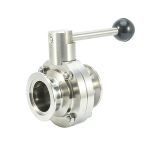
Detailed Explanation of the Four Classification Methods of Pneumatic Butterfly Valves
The editor briefly introduces the four classification methods of pneumatic butterfly valves. The main classifications are divided according to structure form, sealing surface material, sealing form, and working pressure. Let’s take a look!
1. Classified by structure:
1, center sealing butterfly valve
2, single eccentric sealing butterfly valve
3, double eccentric sealing butterfly valve
4, triple eccentric sealing butterfly valve
2. Classified by sealing surface material:
1. Soft sealing butterfly valve: The sealing pair is composed of non-metallic soft material to non-metallic soft material. The sealing pair is composed of metallic hard materials and non-metallic soft materials.
2. Metal hard sealing butterfly valve: The sealing pair is composed of metal hard material to metal hard material.
3. Classified according to sealing form:
1, forced sealing butterfly valve
(1), elastic sealing butterfly valve. The specific pressure of the seal is caused by the valve plate squeezing the valve seat when the valve is closed, and the elasticity of the valve seat or the valve plate produces
2) Seal the butterfly valve with torque. The seal specific pressure is generated by the torque applied to the valve shaft
(3), pressurized sealing butterfly valve. The specific sealing pressure is generated by the pressure of the elastic sealing element on the valve seat or valve plate
(4), automatic sealing butterfly valve. The sealing specific pressure is automatically generated by the medium pressure.
4. Classified by working pressure:
(1), vacuum butterfly valve-butterfly valve whose working pressure is lower than the standard atmospheric pressure.
(2), low pressure butterfly valve—butterfly valve with nominal pressure PN<1.6MPa.
(3) Medium-pressure butterfly valve—butterfly valve with a nominal pressure PN of 2.5-6.4MPa.
(4) High-pressure butterfly valve—the butterfly valve with a nominal pressure PN of 10.0-80.0MPa.
(5) Ultra-high pressure butterfly valve—butterfly valve with nominal pressure PN>100MPa.
The butterfly plate of the butterfly valve is installed in the diameter direction of the pipe. In the cylindrical passage of the butterfly valve body, the disc-shaped butterfly plate rotates around the axis, and the rotation angle is between 0° and 90°. When the rotation reaches 90°, the valve is fully opened. This type of valve should generally be installed horizontally in the pipeline.







